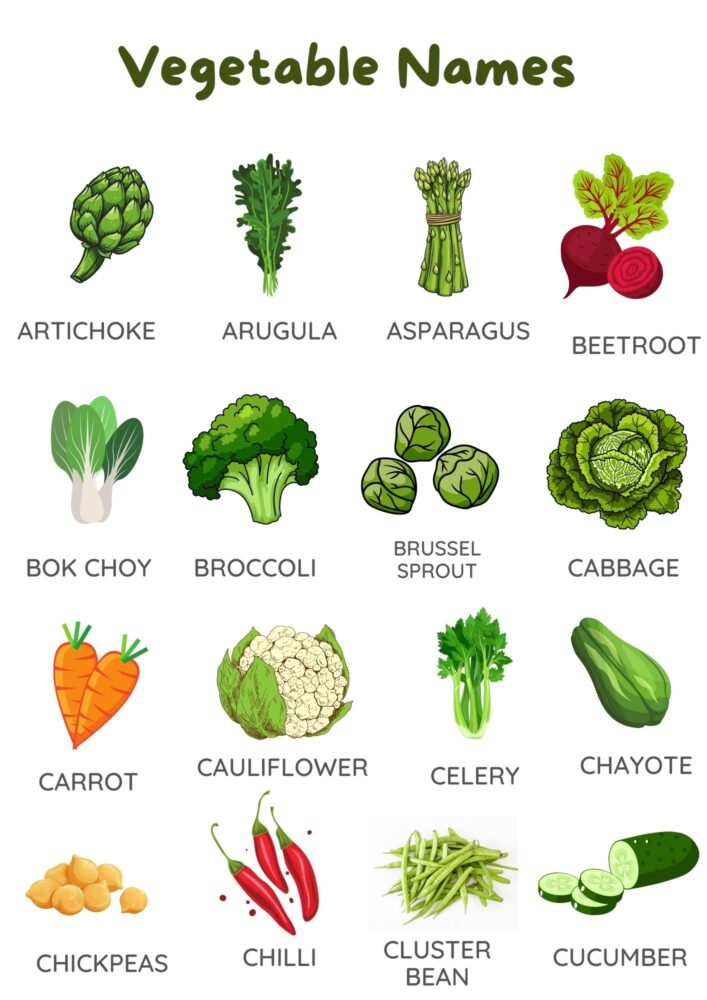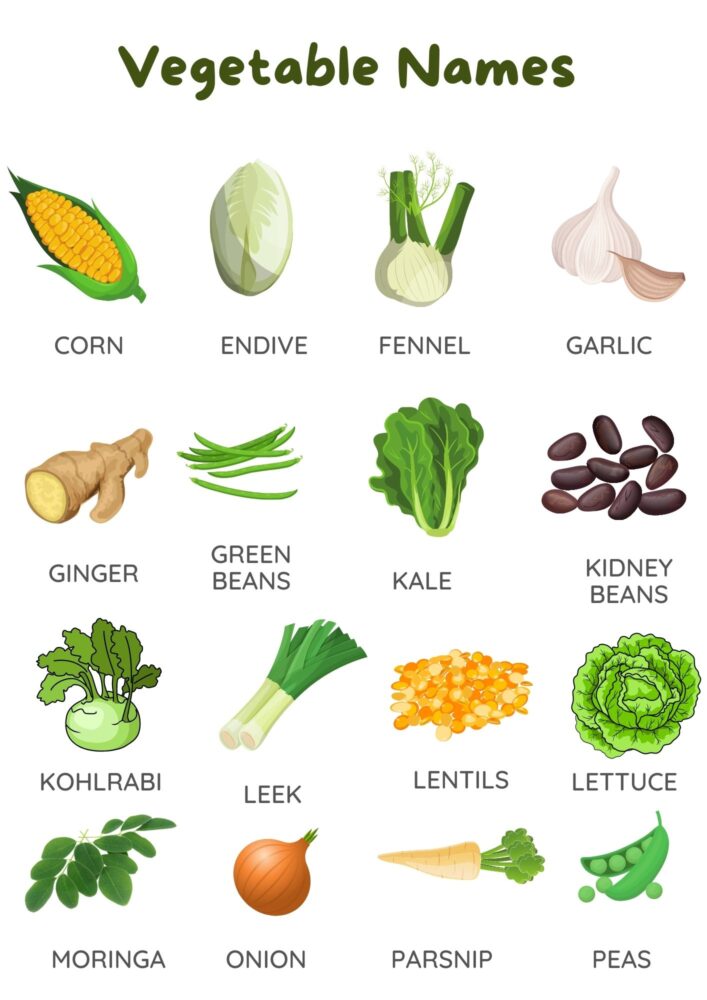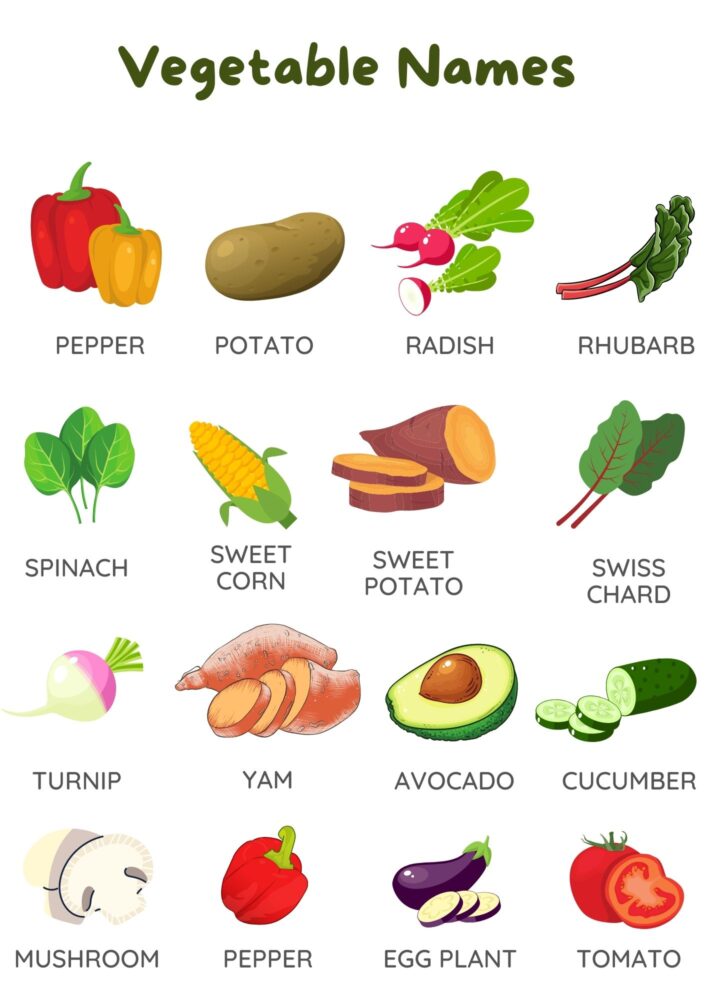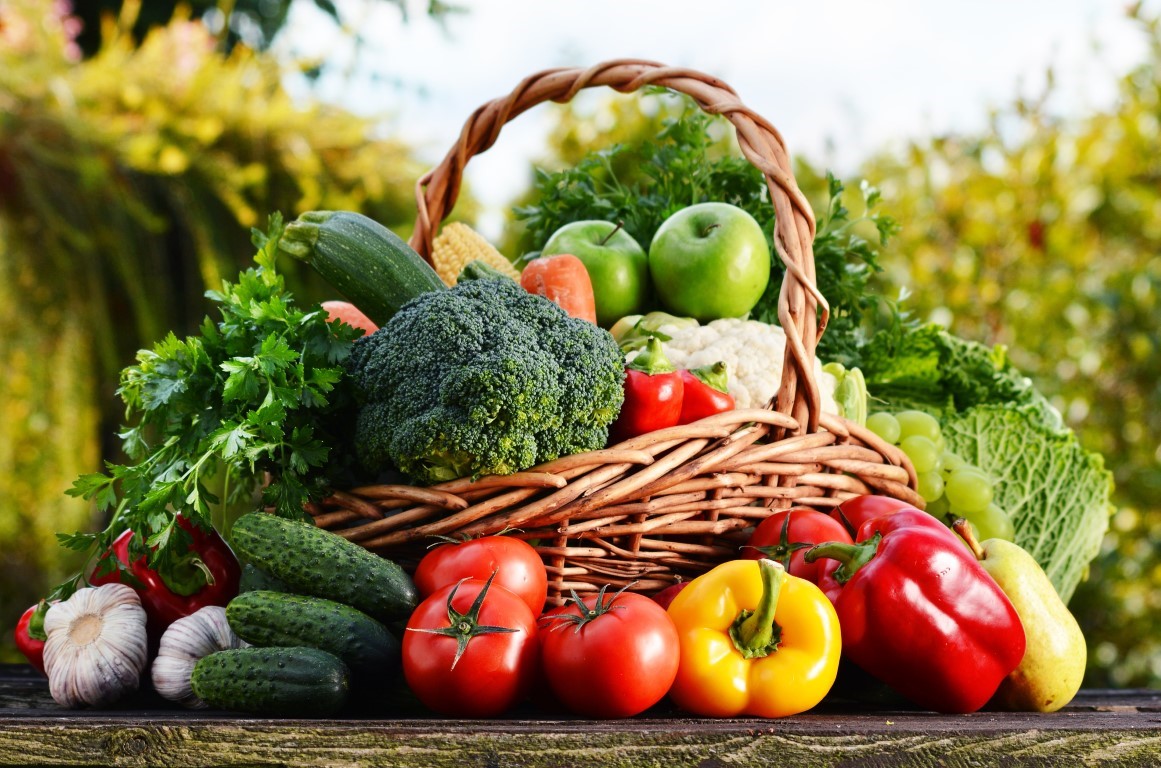Disclosure: This article may contain affiliate links, meaning that when you make a purchase, I earn a small commission. Affiliate links cost you nothing to use and help keep my content free. For more info, see the Disclosure Policy.
Vegetables are an essential part of a healthy diet.
They are packed with nutrients, vitamins, and minerals that our bodies need to function properly. Vegetables also come in a variety of colors, shapes, and sizes, making them fun to eat!
In this blog post, we will explore some of the most popular vegetables in English.
We will provide a list of vegetable names, pictures, and descriptions so you can learn more about them.
Vegetable Names in English List
- Artichoke
- Arugula
- Asparagus
- Beet
- Bok Choy
- Brinjal
- Broccoli
- Brussels Sprout
- Cabbage
- Carrot
- Cauliflower
- Celery
- Chayote
- Chickpeas
- Chilli
- Cluster Bean
- Cucumber
- Corn
- Eggplant
- Endive
- Fennel
- Garlic
- Ginger
- Green beans
- Kale
- Kidney Beans
- Kohlrabi
- Leek
- Lentils
- Lettuce
- Moringa
- Onion
- Parsnip
- Peas
- Pepper
- Potato
- Radish
- Rhubarb
- Spinach
- Sweet Corn
- Sweet Potato
- Swiss Chard
- Turnip
- Yam
Not Actually Vegetables
- Avocado
- Butternut Squash
- Cucumber
- Eggplant/ Bringal
- Mushroom
- Pepper
- Pumpkin
- Zucchini
- Tomato
Vegetable Names with Pictures




Vegetable Names with Description
Artichoke
Artichokes are a type of vegetable that has many different varieties. They can be eaten raw or cooked, but they’re usually steamed and served with butter. Artichoke leaves have thorns on them, so be careful with those!
Arugula
Arugula is a leafy green vegetable that has a peppery flavor. It’s often used in salads or as part of a sandwich filling.
Asparagus
Asparagus is a type of vegetable that has long, thin stalks. It can be eaten cooked or raw, but it’s usually boiled or steamed. Asparagus is a good source of fiber and is high in antioxidants. It also has anti-inflammatory properties, which reduce the risk of heart health.
Beetroot
Beetroot is a type of root vegetable. It has dark purple skin and an earthy flavor, with a sweet taste when cooked. Beets can be eaten raw or cooked into salads or slaws. They’re also great roasted! Beetroot juice helps to lower blood pressure because it contains nitrates that convert into nitric oxide in the body.
Bok Choy
Bok Choy is a type of leafy green vegetable that has long, white stalks. It’s often used in Chinese cooking and can be eaten raw or cooked. Bok choy is a crunchy Chinese cabbage that can be consumed whole.
Broccoli
Broccoli is a type of vegetable that has many different varieties. It can be eaten raw or cooked, but it’s usually steamed and served with butter. A cup of broccoli has the same amount of vitamin C as an orange. It is high in fiber which makes it good for digestion as well as immune health.
Brussels Sprout
Brussels sprouts are a type of vegetable that is related to cabbage. They have small, round leaves and a slightly bitter taste. Brussels sprouts can be boiled, steamed, or roasted. They’re a good source of vitamin K, vitamin C, and fiber.
Cabbage
Cabbage is a type of vegetable that has many different varieties. It is one of the most versatile vegetables that can be eaten raw or cooked, but it tastes great when boiled and flavored with butter. Cabbage contains vitamin K, which helps blood clotting and is packed with vitamin C.
Carrot
Carrots are a type of vegetable that is related to parsnip. They have a long, thin shape and can be eaten raw or cooked. Carrots are high in beta-carotene, which our bodies convert into vitamin A. Vitamin A is important for healthy skin, hair, bones, and teeth.
Cauliflower
There are many types of cauliflower. It can be eaten raw or cooked and are a good alternative to broccoli. The whiter the head of the cauliflower, the fresher it is.
Celery
Celery is a popular low-calorie snack that is rich in vitamins. It contains a good dose of fiber and makes a simple, flexible vegetable that tastes great in salads with apples and parmesan cheese, smoothies, or soups.
Chayote
Chayote is a type of squash that has a pear-like shape. It can be eaten cooked or raw and has a mild flavor. Chayote is high in vitamin C, folate and fibre.
Chickpeas
Chickpeas are a great protein source. They can be eaten raw or cooked and are a great replacement for meat in vegetarian and vegan dishes. Chickpeas are particularly high in manganese and folate.
Chilli
Chilli is a type of vegetable that has many different varieties. Chilies are known for their hot flavor and are primarily used as a spice. They are very healthy for you as they contain vitamin C and vitamin B6, which boosts your metabolism!
Cluster Bean
Cluster beans have long, thin pods and a slightly bitter flavor. They are common in India. Cluster beans are high in fiber and contain Vitamin C and folic acid. Tomatoes are often added to cluster bean dishes to lessen the bitter taste.
Corn
Corn, also known as maize, is a type of vegetable or popular grain. Corn is primarily known for being yellow but can come in many different colors. Popcorn and sweetcorn are well-known varieties. It is composed of carbs and some sugar content but is not a high-glycemic food.
Endive
Endive is a type of leafy vegetable with a slightly bitter taste. It can be eaten raw or cooked and is mainly used in salads. Endives are low in calories but are high in fiber which makes them good for digestion as well as immune health.
Fennel
Fennel is a type of vegetable that has an anise flavor and is one of Italy’s most popular vegetables. It can be eaten raw, sauteed, or roasted and is often used in salads and soup. Fennel is a good source of fiber and nutrients like potassium and folate.
Garlic
Garlic is a type of vegetable and spice that has an oniony flavor. It can be eaten raw or cooked and is used to flavor a wide variety of dishes. Garlic contains many antioxidants and has been used as a medicine throughout ancient and modern history.
Ginger
Ginger is a type of vegetable and spice that has a sharp flavor. It can be eaten raw or cooked and is used to flavor a wide variety of dishes. Ginger is high in antioxidants, and people have been using it in China and India since ancient times.
Green Beans
Green beans, also called string beans or snap beans, are a type of vegetable that grows on vines in the summer and autumn months. They have a long, thin shape and can be eaten raw or cooked, but it’s probably best to cook them. Green beans are high in carotenoids, which our bodies convert into vitamin A. Vitamin A is important for healthy skin, hair, bones, and teeth.
Kale
Kale, also known as leaf cabbage, can be eaten raw or cooked and is considered one of the most nutrient-dense foods. Kale is an excellent source of vitamin C, K and there are many cancer-fighting properties in kale.
You may also be interested in: 55 Symbols Name List in English
Kidney Beans
Kidney beans are a type of legume native to the Americas. They are usually reddish-brown in color, and they are best eaten well-cooked. They are high in protein and are an affordable alternative to animal protein.
Kohlrabi
Kohlrabi is a bulb-shaped type of vegetable that has an apple-like shape. It can be eaten raw or cooked and has a mild flavor with a hint of sweetness. Kohlrabi contains fiber, vitamin C, potassium, and calcium.

You may also be interested in: 15 Best Online English Courses Free & Paid (2022)
Leek
Leeks are a type of vegetable part of the onion family, making them a great alternative to onions. They are often used in soups and stews, and the green part on top can be shredded raw into salads. Leeks are low in calories but high in magnesium and vitamins A, C, and K.
Lentils
Lentils are a type of legume known for its lens-shaped seeds. They are cooked and are often used in soups, casseroles, and salads. They are a common protein source in meat-free diets.
Lettuce
Lettuce is a type of vegetable that has many different varieties. It can be eaten raw or cooked and is mainly used in salads, but can also be added to other dishes. Lettuce is a good source of dietary fiber, vitamin A, B, C, and E.
Mustard Greens
Mustard greens are a type of vegetable that has a spicy flavor. It can be eaten raw or cooked. Mustard greens are an excellent source of vitamin A and K, and they come from the same plant that makes the mustard seed.
Moringa
Moringa is a nutrient-dense vegetable that’s also known as the ‘miracle tree.’ It has been known for centuries for its nutritional and healing properties in Asia and Africa. The flower part can be used to make tea, but the seeds can be roasted and eaten. The immature seed pods are a favorite dish in South Asia and can also be used in soups.
Onion
Onion is one of the most widely used vegetables and the third most used vegetable in the US. It can be eaten raw or cooked and is used in salads, but it can also be added to many other dishes. Onions are high in nutrients like vitamins and minerals.
Parsnip
Parsnip is a type of vegetable that is related to the carrot. It has a sweet yet bitter flavor and can be eaten raw or cooked. Parsnips are high in folate, vitamin C and K.
Peas
Peas are a type of legume that grows in pods on vines. They can be bought fresh or frozen, with very little nutritional difference. They are used in salads, soups, side dishes, and main courses. Peas contain high levels of antioxidants, vitamins A, C, and K, as well as dietary fiber.
Pepper
Peppers come in many different colors, shapes, and sizes. They can be eaten raw or cooked and complement a variety of dishes, such as salads, soups, and stir-fries. Peppers are a popular healthy fruit and are a good source of antioxidants and vitamins C, E, and beta carotene.
Potato
Potato is a starchy and versatile ingredient that can be boiled, baked, or fried. They can also be made into fries potato chips or used for other recipes. Potatoes are a good source of dietary fiber, potassium, and vitamin C.
Radish
Radish is a vegetable that has a mild or peppery flavor. It can be eaten raw or cooked and is often used in salads sandwiches or can be eaten with hummus for a healthy snack. Radishes are low in calories but high in nutrients like potassium and calcium.
Rhubarb
Rhubarb is a type of vegetable that is not related to the celery plant, but the stalks look very similar. It has a tart and sour flavor and can be eaten raw or cooked. Rhubarb can be made into tarts, jams, and crumbles.
Spinach
Spinach is a leafy vegetable related to beets and quinoa. It is considered a superfood and can be eaten raw or cooked. Spinach has many health benefits, and it contains high levels of iron, magnesium, and calcium, as well as vitamins A and K.
Sweet Potato
Sweet potato is a starchy vegetable that has many different varieties, some being sweeter than others. Surprisingly, they are not related to the regular potato and come from a different family group of vegetables. Sweet potato contains high levels of fiber potassium and is rich in vitamin A.
Swiss Chard
Swiss Chard is a leafy green vegetable related to beets and spinach. It has a slightly bitter taste and is more often cooked to mellow the bitterness. Swiss chard is high in vitamins A, C, and K, as well as minerals like potassium and magnesium.
Turnip
Turnip is a root vegetable that has a similar texture to the potato. It can be eaten raw or cooked, with roasting brings out the best of their flavors. Turnips can be used in soups, stews, stir-fries, or mashed into slaw. Turnips have many nutrients, are high in fiber, and are a good source of omega 3 fatty acids.
Yam
Yam is a root vegetable and more earthy in flavor when compared to sweet potato. Yams are grown in tropical regions and can be fried, roasted, boiled, or steamed. Yams contain many nutrients like vitamin C and B vitamins as well as fibre, manganese, potassium, and copper.
Not Actually Vegetables
Avocado

Butternut Squash

Cucumber

Eggplant/ Brinjal

Mushroom

Pepper

Pumpkin

Tomato

Zucchini

Useful Links
- A Guide to Fruit Names Around the World
- 3D Shape Names in English (Beginner Friendly)
- 41 Flower Names in English with Pictures (Flower List)
- +40 List of Sea Animals with Pictures
- Color Names List in English with Pictures (36 Colors!)
- +180 Kitchen Utensils Name List with Pictures
Caitriona Maria is an education writer and founder of TPR Teaching, crafting inspiring pieces that promote the importance of developing new skills. For 7 years, she has been committed to providing students with the best learning opportunities possible, both domestically and abroad. Dedicated to unlocking students' potential, Caitriona has taught English in several countries and continues to explore new cultures through her travels.

